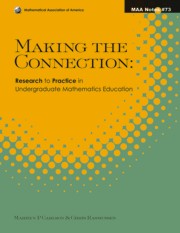Book contents
- Frontmatter
- Preface
- Contents
- Part 1 Student Thinking
- 1a Foundations for Beginning Calculus
- 1 On Developing a Rich Conception of Variable
- 2 Rethinking Change
- 3 Foundational Reasoning Abilities that Promote Coherence in Students' Function Understanding
- 4 The Concept of Accumulation in Calculus
- 1b Infinity, Limit and Divisibility
- 5 Developing Notions of Infinity
- 6 Layers of Abstraction: Theory and Design for the Instruction of Limit Concepts
- 7 Divisibility and Transparency of Number Representations
- 1c Proving Theorems
- 8 Overcoming Students' Difficulties in Learning to Understand and Construct Proofs
- 9 Mathematical Induction: Cognitive and Instructional Considerations
- 10 Proving Starting from Informal Notions of Symmetry and Transformations
- 11 Teaching and Learning Group Theory
- 12 Teaching for Understanding: A Case of Students' Learning to Use the Uniqueness Theorem as a Tool in Differential Equations
- Part 2 Cross-Cutting Themes
- About the Editors
3 - Foundational Reasoning Abilities that Promote Coherence in Students' Function Understanding
from 1a - Foundations for Beginning Calculus
- Frontmatter
- Preface
- Contents
- Part 1 Student Thinking
- 1a Foundations for Beginning Calculus
- 1 On Developing a Rich Conception of Variable
- 2 Rethinking Change
- 3 Foundational Reasoning Abilities that Promote Coherence in Students' Function Understanding
- 4 The Concept of Accumulation in Calculus
- 1b Infinity, Limit and Divisibility
- 5 Developing Notions of Infinity
- 6 Layers of Abstraction: Theory and Design for the Instruction of Limit Concepts
- 7 Divisibility and Transparency of Number Representations
- 1c Proving Theorems
- 8 Overcoming Students' Difficulties in Learning to Understand and Construct Proofs
- 9 Mathematical Induction: Cognitive and Instructional Considerations
- 10 Proving Starting from Informal Notions of Symmetry and Transformations
- 11 Teaching and Learning Group Theory
- 12 Teaching for Understanding: A Case of Students' Learning to Use the Uniqueness Theorem as a Tool in Differential Equations
- Part 2 Cross-Cutting Themes
- About the Editors
Summary
The concept of function is central to undergraduate mathematics, foundational to modern mathematics, and essential in related areas of the sciences. A strong understanding of the function concept is also essential for any student hoping to understand calculus — a critical course for the development of future scientists, engineers, and mathematicians.
Since 1888, there have been repeated calls for school curricula to place greater emphasis on functions (College Entrance Examination Board, 1959; Hamley, 1934; Hedrick, 1922; Klein, 1883; National Council of Teachers of Mathematics, 1934, 1989, 2000). Despite these and other calls, students continue to emerge from high school and freshman college courses with a weak understanding of this important concept (Carlson, 1998; Carlson, Jacobs, Coe, Larsen & Hsu, 2002; Cooney & Wilson, 1996; Monk, 1992; Monk & Nemirovsky, 1994; Thompson, 1994a). This impoverished understanding of a central concept of secondary and undergraduate mathematics likely results in many students discontinuing their study of mathematics. The primarily procedural orientation to using functions to solve specific problems is absent of meaning and coherence for students and has been observed to cause them frustration (Carlson, 1998). We advocate that instructional shifts that promote rich conceptions and powerful reasoning abilities may generate students' curiosity and interest in mathematics, and subsequently lead to increases in the number of students who continue their study of mathematics.
This article provides an overview of essential processes involved in knowing and learning the function concept.
- Type
- Chapter
- Information
- Making the ConnectionResearch and Teaching in Undergraduate Mathematics Education, pp. 27 - 42Publisher: Mathematical Association of AmericaPrint publication year: 2008
- 98
- Cited by

